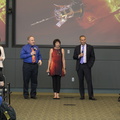
WIKIARCHIVES.SPACE
The Human Spaceflight Archive

Information
- Taken in
- Kennedy Space Center
- Author
- NASA/Kim Shiflett
- Description
- In the Kennedy Space Center's Operations and Support Building II, Thursday, Aug. 9, 2018, members of the media participate in a prelaunch mission briefing on NASA's Parker Solar Probe. Listening to the presentation is Eugene Parker, front row, far left, the S. Chandrasekhar Distinguished Service Professor Emeritus, Department of Astronomy and Astrophysics at the University of Chicago. This is the first NASA mission that has been named for a living individual. The Parker Solar Probe will lift off on a United Launch Alliance Delta IV Heavy rocket from Space Launch Complex 37 at Cape Canaveral Air Force Station in Florida. The spacecraft was built by Applied Physics Laboratory of Johns Hopkins University in Laurel, Maryland. The mission will perform the closest-ever observations of a star when it travels through the Sun's atmosphere, called the corona. The probe will rely on measurements and imaging to revolutionize our understanding of the corona and the Sun-Earth connection.
- Created on
- Thursday 9 August 2018
- Albums
- US SPACE PROGRAM / PROBES / SUN / PARKER SOLAR PROBE / Rocket preparation
- Source link
- https://www.flickr.com/photos/nasakennedy/albums/72157684283574591
- Visits
- 17
- Rating score
- no rate
- Rate this photo
- License
- CC BY-NC-ND
- Modified by WikiArchives
- No (original)
- Downloads
- 0
EXIF Metadata
Canon Canon EOS 5D Mark IV
- Make
- Canon
- Model
- Canon EOS 5D Mark IV
- DateTimeOriginal
- 2018:08:09 13:20:23
- ApertureFNumber
- f/3.2
Powered by Piwigo
















